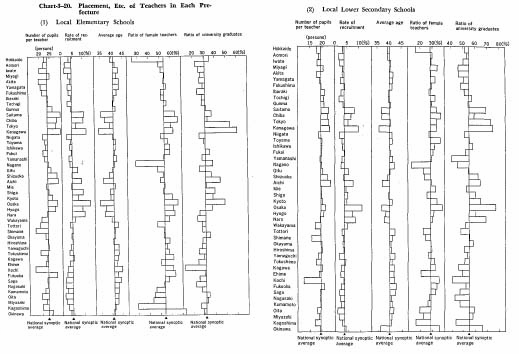| Home > Policy > White Paper, Notice, Announcement > White Paper > EDUCATIONAL STANDARDS IN JAPAN 1975 > CHAPTER3 6 | ||
As the indicators of the state of recruitment, placement, etc. of local elementary and lower secondary school teachers in each prefecture, the number of pupils per teacher, rate of recruitment, average age, ratio of female teachers and ratio of university graduates in each prefecture are graphically presented in Chart 3-20.
For local elementary schools, the prefectures showing a larger number of pupils per teacher, a higher, rate of recruitment, ratio of female teachers and ratio of university graduates and lower average age, include Saitama, Claiba, Tokyo, Kanagawa, Kyoto, Osaka, Hyogo, etc., whereas the prefectures, showing conversely a smaller number of pupils per teacher, a lower race of recruitment, ratio of female teachers and ratio of university graduates and a higher average age include Aomori, Iwate, Akita, Fukushima, Yamanashi, Tottori, Kumamoto, Kagoshima, etc.
Viewing the relationship of the various indicators on recruitment, placement, etc. of teachers in those prefectures to the social and economic indicators, shown in the Referential Chart (Cf. page 373), it is found that all the prefectures falling under the former category (see previous paragraph) show high values in all social and economic indicators, reflecting a high degree of "urbanization," whereas those prefectures falling under the latter category show a low degree of urbanization.
As for local lower secondary schools as well, nearly the same trend is shown as in the case of local elementary schools.


| Back to Top | MEXT HOME |